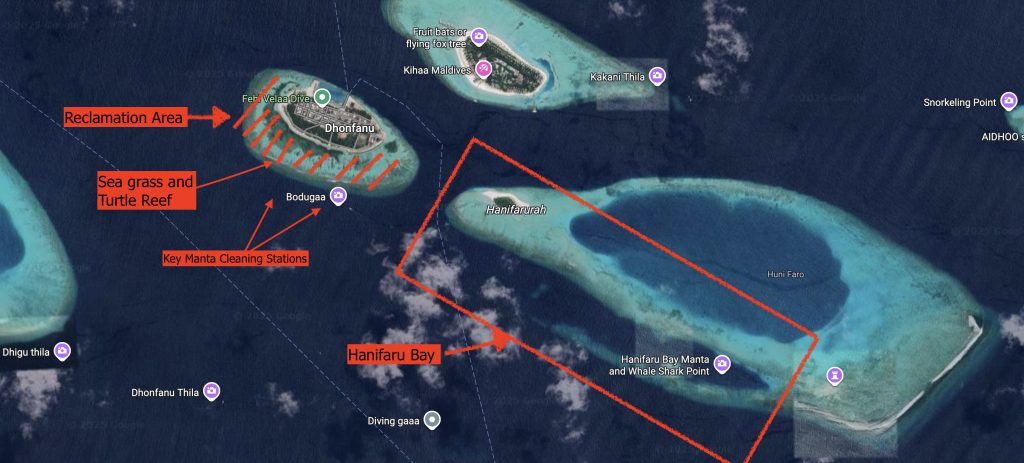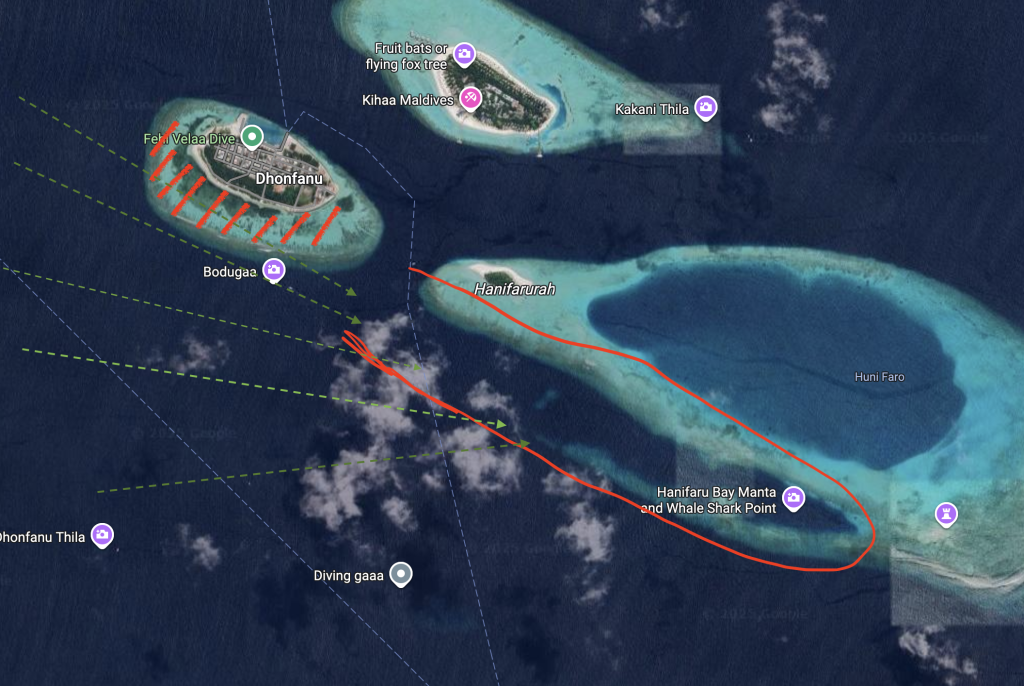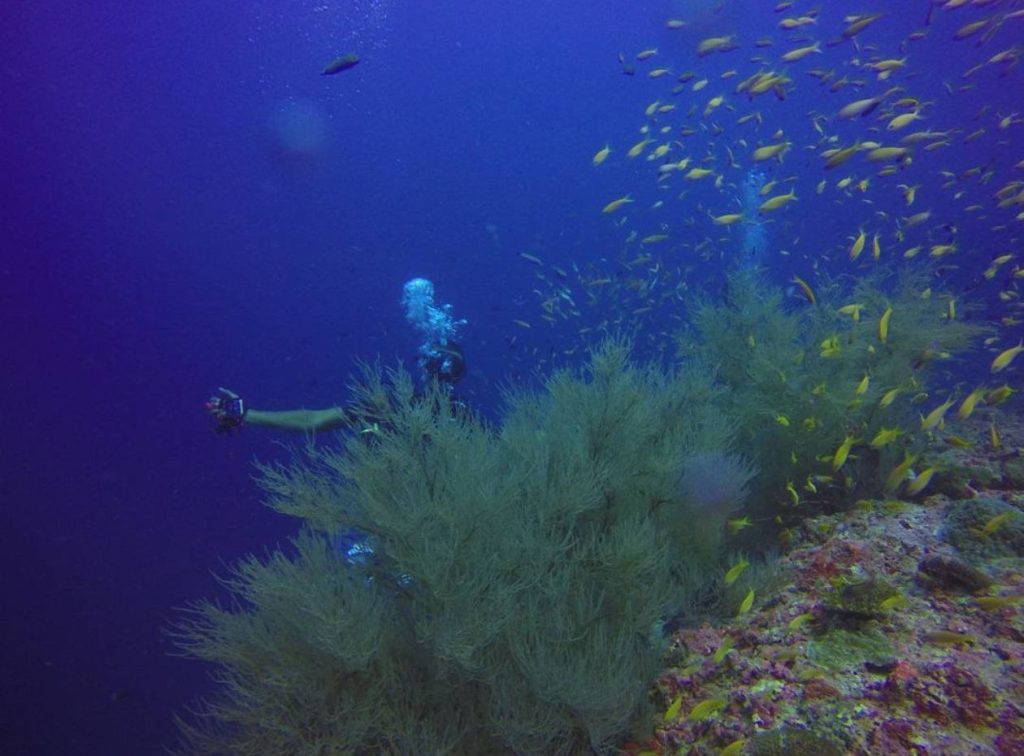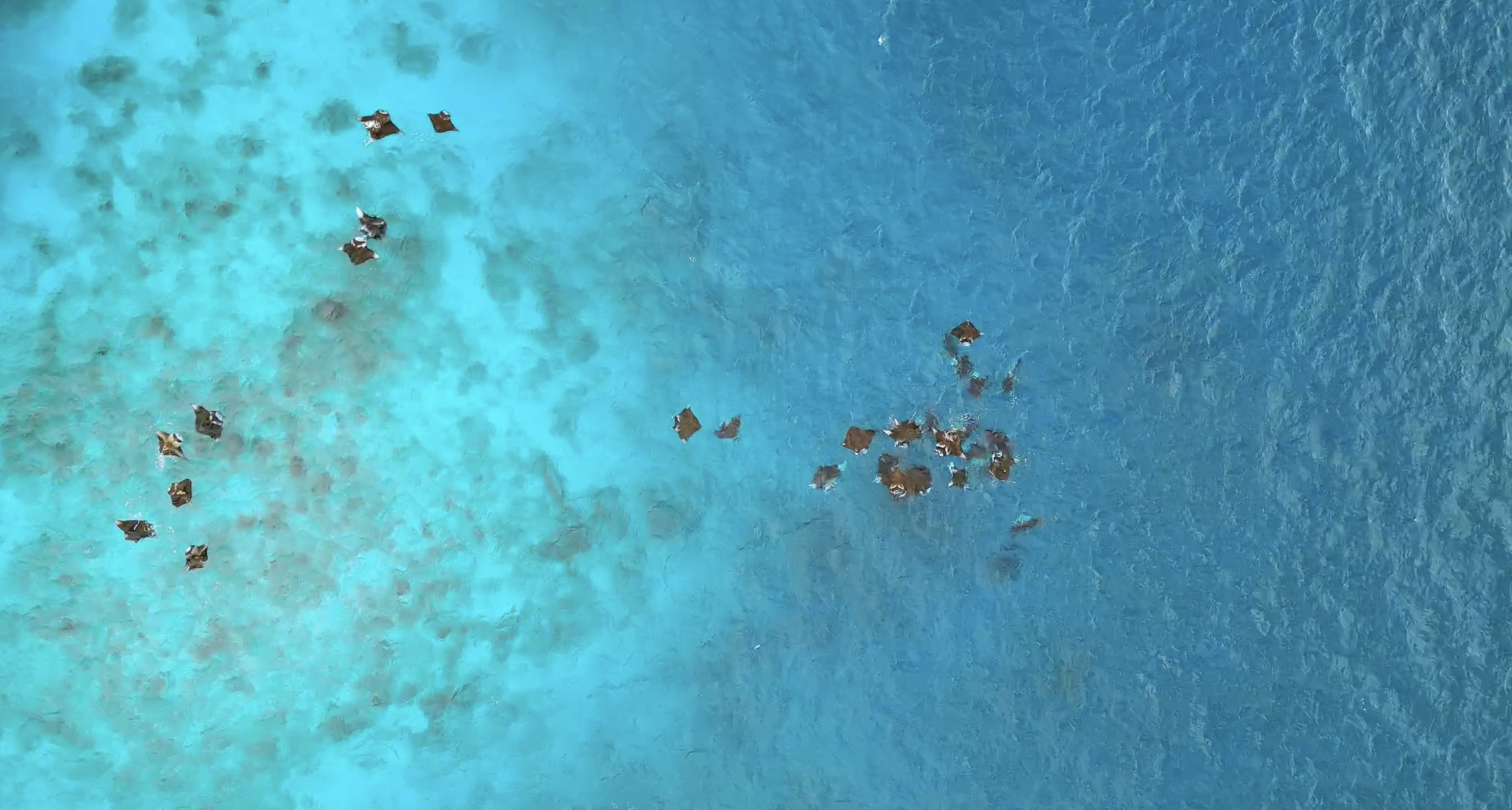Hi, this is the team at Manta Nomads. We wanted to share something a bit different from our usual posts. Something more personal and urgent. We recently launched this space with the intention to share about diving, stories, and everything ‘Baa Atoll’.
Today, however, we feel compelled to address the recent land reclamation project taking place in the very heart of the UNESCO Biosphere reserve. We are writing this amid the busy weeks of the Manta season, alongside our team members juggling other critical work in and outside the dive center. So please excuse any imperfections in our writing. We are also writing in light of the best information as the news of the project was very sudden and we are still trying to get more clarity on everything.
We wanted to share our perspective as a dive centre and small business. Whom on one hand we interact with the Manta and unique biodiversity in the region on a daily basis. And on the other we have also looked (and continue to look) into the tourism of Baa Atoll from a business perspective. The tourism of a designated marine protected area (MPA) that contribute millions of dollars back to the economy via tourism, which is the economic life blood of the country.
Hanifaru Bay: The heart of the UNESCO Biosphere reserve
Baa Atoll has been designated a UNESCO Biosphere Reserve since 2011, recognized for its extraordinary marine biodiversity, especially its large population of resident manta rays.
The atoll’s unique geography is best known for its crown jewel: Hanifaru Bay, the world’s largest known aggregation site for manta rays. It is one of the only places on Earth where hundreds of mantas regularly gather to feed in a single session. Often times these numbers are in hundreds and sometimes reaching record sightings of more than 300 individuals at one time.
Background: Dhonfanu Land Reclamation Project

The signed project, is a land reclamation project to reclaim 13 hectares of land from the lagoon of Dhonfanu Island. The purpose being to extend the island’s usable land area for numerous purposes. The island, which has a registered population of 398 people, is located 1km from hanifaru bay and is also in close proximity to all the major dive and snorkel hotspots in the region.

While adjacent to Hanifaru Bay, the reclamation area is also next to the Turtle Reef, one of the Maldives’ most popular turtle snorkelling spots. In front of the reef are two of the most popular manta dive sites, totalling more than four manta cleaning stations. To the south-west is Dhonfanu Thila and to the east is the UNESCO Thila area, which is also known for its incredible biodiversity and coral formations
The land reclamation project was signed on the 13th of August 2025 to commence operations. This was concerning news for the dive centres, local islands, guest houses, and all operators in the region, whose very livelihood and income are strongly tied to this marine hotspot.
We are also looking forward to see a detailed Environmental Impact Assessment Report (EIA) report on the project, which will serve as an essential tool for understanding the potential impact this reclamation will have on a marine protected area designated as a UNESCO Biosphere Reserve.
…. Low visibility snorkel due to plankton blooms. Manta Rays chasing the plankton during a feeding session ….
This area of Baa is unique: It is the ocean currents that decide everything here
What brings thousands of manta rays and dozens of whale sharks to this region are the seasonal plankton blooms during the South West Monsoon, which occurs from May to November. Ocean currents gather vast concentrations of plankton and funnel it into Hanifaru Bay and its areas.
This abundance of food attracts filter feeders from near and far. From the manta rays residing in Baa Atoll and nearby Atolls, to whale sharks that migrate from places as distant as South Ari Atoll to feed during the Manta Season. These creatures rely on this small, rich area for feeding, making it a critical hub in their seasonal migration and life cycle
With the lifecycle and migration patterns, we fear any impact on this region has the possibility of disrupting this delicate balance which could cause detrimental ripple effects beyond this Atoll
Our Concerns

Our primary concerns stem from the reclamation site’s direct proximity to these critical marine areas. We must ask: what impact will the introduction of such a large, artificial landmass have on the delicate ocean currents that govern this entire ecosystem? What impact will it have on bringing and trapping planktons to the ‘mouth shaped’ Hanifaru bay which is the Manta’s main feeding area?
We have concerns the dredging work will alter the area geographically, disturbing the natural plankton flow, causing unforseen negative consequences for both sea life and the income from tourism that comes with it.
Furthermore, we are deeply worried about the massive sediment plumes that will be generated during the reclamation process. How far will this silt spread, and how severely will it smother the coral reefs, seagrass beds, and cleaning stations in nearby areas? How will the sediment that gets mixed with the planktons blooms taken into hanifaru bay sustain the critical feeding cycle of Manta Rays?
We are also concerned of the longer term implications and the ripple affect it will have on other regions if something happens to the plankton activity
Whale sharks and Manta rays come here to feed as part of their annual cycle. What will happen to other regions if this cycle gets disrupted? How will it affect the whale sharks travelling back and forth between the SAMPA region in South Ari and Baa Atoll? What will become of the Manta Ray migratory patterns where they come to Baa Atoll in the South West monsoon and disperse to Raa Atoll and even as far as Haa Alif Atoll after the season? What forms of changes will come to their migration patterns and yearly cycles if there are changes to this delicate region?
Sites nearby and possible areas that can be affected
Hanifaru Bay

Located only 1km east from the site. This is the crown jewel of Baa Atoll and the central critical feeding area of Manta rays. Where hundreds of Manta rays gather at a single feeding session.
Our greatest concern is the bay’s proximity to the project. The reclamation is situated directly in front of the “mouth” of the bay which is the very opening where currents channel plankton inward. We fear that during construction, suspended sediment will mix with plankton-rich waters and be carried into the bay on incoming tides. After completion, the altered seabed and new landmass could permanently disrupt the natural flow of currents.
…. What we call a Manta Train feeding behaviour at Hanifaru Bay ….
It’s important to understand: even a slight shift in water current patterns can scatter plankton, something which we have observed quite often with changing tides and weather. And any permanent shift in water currents can scatter the mantas away from the bay entirely.
Turtle Reef
The turtle reef is one of the most popular turtle snorkeling spots in Maldives The area around Dhonfanu, especially in the approved reclamation zone, is full of sea grass which is the primary food source for Green sea turtles. The reef around is a place where green sea turtles rest, and is also a reef where countless hawksbill sea turtles feed and call home in addition to a vast majority of other fish species including batfish and blacktip reef sharks. It is common to observe 8, 12 or even 15 different turtles on a good snorkeling session.
Kuda Gaa
…. Manta Rays co-exist with a diverse range of marine life here ….
One of the pinnacles that are connected to Dhonfanu Reef situated in front of the reclamation site. The entire top reef can become a Manta Cleaning Station on the South-West Monsoon. Green sea turtles can be present resting on various places of this dive site
…. Can come across lot of Manta and Turtles together at Kuda Gaa ….
Bodu Gaa
Bodu Gaa one of the few pinnacles close to the southern side of Dhonfanu reef close to the reclamation site. It’s close enough for divers to cross from the reef to the pinnacle. The entire pinnacle is covered with hard corals and is an ideal place to spot green sea turtles resting. The site itself is also a cleaning stations for mantas during the season and due to the uniqueness of the subaquatic geological features, the area around it is a reservoir that gathers plankton in amounts for mantas (sometimes in aggregations of more than 50 at a time) and whalesharks to come and feed on them
…. Manta Rays by the dozens (actually 50+) near Bodu Gaa ….
UNESCO thila / Ujaalaa thila

According to divers, this is also a potentially endangered site from the sediments coming in from the currents. This area is rich in coral life and underwater greenery.
Dhonfanu Thila
Located slightly South West of Dhonfanu. The pinnacle is located between Dharavandhoo, Anga Faru and Dhonfanu. The dive site is one of the most unique dive sites in Maldives especially known for its beautiful swimthrough on it’s east side where divers can enter at around 30 meters and exit at 18 meters.
…. Swimthrough of Dhonfanu Thila ….
Kihaadhuffaru thila
A pinnacle connected to the east side of Kihaadhuffaru Reef, behind dhonfanu island. Home to Eagle Rays, Grey Reef sharks in the current, Blue Lined Snappers and Red Snappers, Nurse sharks underneath overhangs, and macro life like nudibranchs and mantis shrimps. A unique site still at risk from sediment plumes
…. Kihaadhuffaru Thila at its best ….
The unique Tourism of Baa Atoll: High value operators – operating year round
While we point at the the ecological risks. It is also impossible to ignore the economic stakes. Any damage to this ecosystem doesn’t just harm wildlife but also jeopardizes an economic engine that supports livelihoods, attracts premium investment, and generates vital national revenue. We want to highlight more about the unique nature of tourism in this UNESCO Biosphere Reserve along with the economic value of Manta tourism in the Atoll.
The Ecological High Season (May – November)
Baa Atoll is so unique such that it is one of the few places in Maldives that has an year-round tourist season. Contrary to the term “off-season,” this period of the Southwest Monsoon between May and November (Hulhangu) is infact our ecological peak season where Mantas and Whale sharks gather in extra ordinary numbers.
Divers and snorkelers whom wish to see this unique phenomenon specifically book their trips for this time of the year. As a result, dive centers, guest houses, and excursion operators across Baa are consistently heavily booked from late July onward, with demand stretching seamlessly into the traditional tourist season.
The Traditional Tourist Season (November – April)
The arrival of the Northeast Monsoon (Iruvai) in November marks the classic Maldivian tourist season. This period attracts holiday goers who come to explore the beautiful beaches, sandbanks, and sightings of dolphins and turtles in the region.
While the manta rays and whale sharks have moved on, the dives are still exceptional. The clear water, free from plankton blooms, offers superb visibility, revealing the atoll’s beautiful coral pinnacles and underwater landscapes.
This season is also ideal for fishing activities such as big-game fishing, with yellow-fin tuna and Wahoo abundant throughout the atoll’s waters.
Economics of an year round season
The unique ecological rhythm of Baa Atoll creates a powerful economic model. Providing:
- Best use of bed capacity and resources where it is utilised year round
- The “Ecological High Season” ensures a critical inflow of USD to the economy during the tourist offseason in Maldives
- Business profit and sustained revenue, as opposed to many parts of the country that make profit only 4-5 month high seasons
Premium Tourism – Premium Income to the economy
Seasonal dynamics, biodiversity and beautiful beaches of Baa have attracted local and foreign high-value tourism operators to the region. The region is home to some of the world’s most renowned ultra-luxury resorts, including Soneva, Four Seasons, and Dusit Thani and many more operations.
Also, a good majority of the Maldives’ live-aboard (safari) fleets base their operations in Baa Atoll during the tourist off season due to its Manta and whale shark activity during this time.
Baa Atoll is also home to the biggest dive centres operating in the country as there is something to dive for year round. All dive centres and excursion centres in the surrounding islands depend greatly on the regions around Dhonfanu Island and Hanifaru Bay. Local tourism establishments particularly in the islands of Maalhos, Dharavandhoo, Kihaadhoo depend on the region. As the same with the surrounding resorts.
The economics of this region are substantial and far-reaching:
- Significant GDP Contribution: Tourism in Baa Atoll is a major economic driver, Manta Ray Tourism alone is reported to generate over $8.1 million in direct revenue to the nation annually. If we factor in the revenue of tourism in Baa Atoll it will be hundreds of millions of USD
- Infrastructure Development: This premium tourism attracts significant investment. For example Dharavandhoo Airport is one of the few domestic airports in the country where all domestic operators operate to. With numerous domestic flights full daily.
- Community Empowerment: The flow of visitors supports not only resorts and dive centers but also a vast ecosystem of local businesses, transport services, and guesthouses, distributing income across the community.
It must also be noted that recent official figures also show Baa Atoll to be the Atoll with the 3rd highest contribution to our GDP, where this income is largely from tourism and its related businesses.

Our Request
We humbly urge for greater transparency and detailed information regarding the Dhonfanu reclamation project. The potential risks of altering such a sensitive and complex ecosystem are too significant.
We implore the relevant authorities to conduct a comprehensive Environmental Impact Assessment (EIA) that examines:
- The project’s specific impact on the ocean currents and plankton activity that are the lifeblood of this UNESCO Biosphere Reserve.
- The short and long-term risks to the region’s unparalleled biodiversity, particularly the manta rays and whale sharks. And how this impacts the annual migratory cycles of Manta rays and Whalesharks within and beyond the Atoll.
- A thorough analysis weighing the purported benefits of this project against the immense potential risks to both the environment and the economic prosperity of the region.’
The future of Baa Atoll depends on decisions made with the utmost care. And we call for your commitment to preserving this unique gem of Maldives that sustains us all.

Leave a Reply